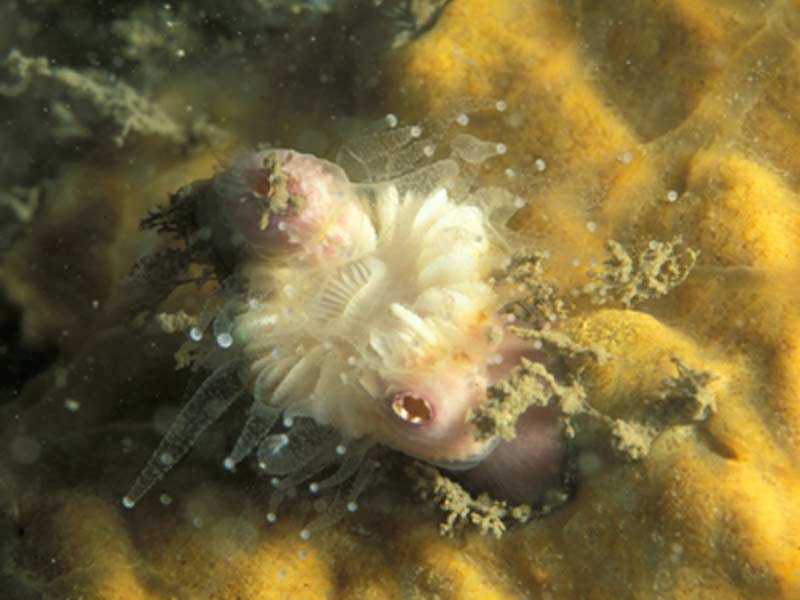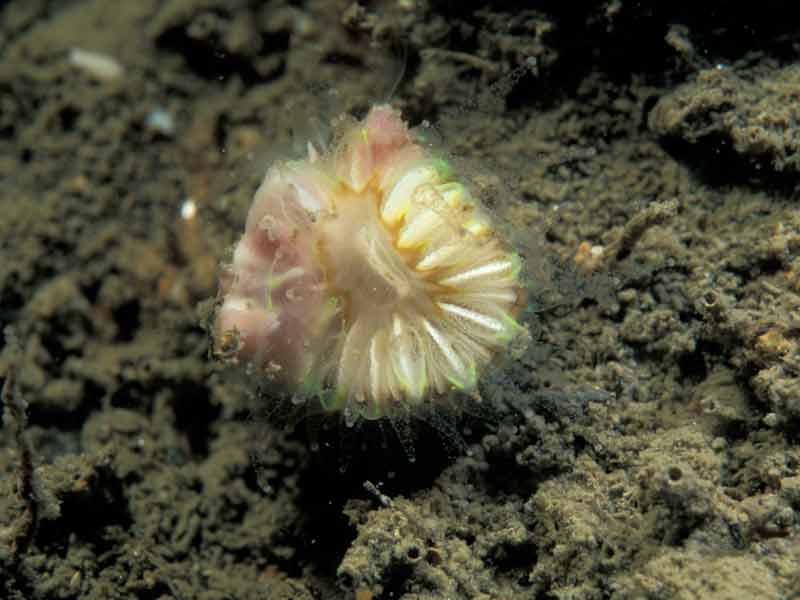A barnacle (Adna anglica)
Distribution data supplied by the Ocean Biodiversity Information System (OBIS). To interrogate UK data visit the NBN Atlas.Map Help
| Researched by | Anna Neish | Refereed by | Admin |
| Authority | Sowerby, 1823 | ||
| Other common names | - | Synonyms | Pyrgoma anglica , Megatrema anglica |
Summary
Description
Recorded distribution in Britain and Ireland
Restricted to the south west of the British Isles, from Exmouth, south Devon to Elwill Bay in north Devon. Also found on the south west coasts of Pembrokeshire and Ireland but does not replicate the distribution of its host as it is a warm water species.Global distribution
-Habitat
Adna anglicum lives in association with corals where it attaches to their calcareous skeletons. Adna anglicum is found mainly on Caryophyllia smithii and was found on 30-50% of corals collected in the south west (Hiscock & Howlett, 1976) but it has also been found on at least eight genera including the British species: Leptopsammia pruvoti, Balanophyllia regia and Hoplangia durotrix. It is found on the shore in shaded places to 50 m and less often in sheltered waters.Depth range
-Identifying features
- A conical shell up to 6mm in diameter with a cup shaped base.
- Longitudinal striations on the outer shell.
- Depressed operculum.
- Found only attached to corals, usually Caryophyllia smithii.
- Attached near the living tissues of the corals.
Additional information
Another barnacle, Verruca stroemia may be found low down on the column of Caryophyllia smithii but only Adna anglicum has succeeded in adapting to settle on the living region of the coral. Its larvae appear unaffected by the coral defence system, and a heavy infestation of Adna anglicum may hamper the coral's food gathering ability (Rees, 1962).Listed by
- none -
Bibliography
Fish, J.D. & Fish, S., 1996. A student's guide to the seashore. Cambridge: Cambridge University Press.
Hayward, P.J. & Ryland, J.S. (ed.) 1995b. Handbook of the marine fauna of North-West Europe. Oxford: Oxford University Press.
Hiscock, K. & Howlett, R. 1976. The ecology of Caryophyllia smithii Stokes & Broderip on south-western coasts of the British Isles. In Underwater Research (ed. E.A. Drew, J.N. Lythgoe & J.D. Woods), pp. 319-344. London: Academic Press.
Moyse, J., 1971. Settlement and growth pattern of the parasitic barnacle Pyrgoma anglicum. Fourth European Marine Biology Symposium. Ed. D.J. Crisp.
Rees, W.J., 1962. The distribution of the coral Caryophyllia smithii and the barnacle Pyrgoma anglicum in British waters. Bulletin of the British Museum (Natural History) (Zoology), 9, 401-418.
Datasets
NBN (National Biodiversity Network) Atlas. Available from: https://www.nbnatlas.org.
OBIS (Ocean Biodiversity Information System), 2025. Global map of species distribution using gridded data. Available from: Ocean Biogeographic Information System. www.iobis.org. Accessed: 2025-07-21
Citation
This review can be cited as:
Last Updated: 26/11/2003




